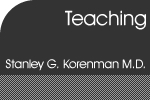

|
<< Previous Section | < Previous Page | Next Page > | Next Section >>
Bibliography (page 13 of 13) Miller, F. G. and A. F. Shorr (2002). "Ethical Assessment of Industry-Sponsored Clinical Trials*: A Case Analysis." Chest 121(4): 1337-1342. These authors review a single randomized control trial of asthma therapy in children for its ethical characteristics and find it faulty. This is worthwhile reading. http://www.chestjournal.org/cgi/content/abstract/121/4/1337 Schroter, S., J. Morris, et al. (2004). "Does the type of competing interest statement affect readers' perceptions of the credibility of research? Randomised trial." BMJ 328(7442): 742-743. An empirical study noting a competing financial interest on receiving research support on various aspects of a study. Believability and relevance were both significantly reduced in the presence of a financial conflict. All in all, a weak paper, but provocative. http://bmj.bmjjournals.com/cgi/content/full/328/7442/742 Resnik, D. (2004). "Disclosing conflicts of interest to research subjects: an ethical and legal analysis." Accountability in Research 11(2): 141-59. The author makes the case that investigators have an ethical and now a legal obligation to disclose their conflicts of interest in a manner such that the study participants will have enough information to sign an informed consent. He argues that disclosure of conflicts of interest should be required in informed consent documents. Campbell, E., B. Moy, et al. (2004). "Institutional academic industry relationships: results of interviews with university leaders." Accountability in Research 11(2): 103-18. The investigators conducted interviews of university leaders to get their viewpoints on academic-industry relationships. Generally, there were many such relationships and these were generally thought to be constructive. There was understanding that conflicts of interest were pervasive and sometimes risky. Holmes, D. R., B. G. Firth, et al. (2004). "Conflict of interest." American Heart Journal 147(2): 228. This report of an expert meeting reviews conflict of interest issues from the level of the investigator on to the FDA. It has become somewhat dated because of the recent NIH revelations and rule development and progress in registering clinical trials. Bernstein, M. (2003). "Conflict of interest: It is ethical for an investigator to also be the primary care-giver in a clinical trial." Journal of Neuro-Oncology 63(2): 107. The author addresses one of the issues of the day. He comes down in opposition to the AAME report on individual conflicts of interest in clinical research, as supporting such research in many instances. http://www.springerlink.com/openurl.asp?genre=articledoi:10.1023/ A:1023959021758 Komesaroff, P. (2005). "Ethical issues in the relationships with industry: an ongoing challenge. New Guidelines open for public comment." J Paediatr Child Health 41(11): 558-60. In this paper the author explains the extent to which medical decision-making in Australia is influenced by industry. He provides guidelines to Australian physicians as to their behaviors, including the rejection of gifts, subsidized attendance at meeting, and samples. They should not endorse specific products. Clinicians should also avoid recruiting their patients into studies in which they are investigators, as well as only doing studies in which there is a commitment to make the results public. This should be followed by an empirical study on compliance. http://www.blackwell-synergy.com/doi/abs/10.1111/j.1440-1754.2005.00719.x Topol, E. J. and D. Blumenthal (2005). "Physicians and the Investment Industry." JAMA 293(21): 2654-2657. In this excellent paper the authors identify and discuss the new practice of clinical researchers providing information to investment groups as consultants. In a number of instances it appears that confidential information was leaked that gave investors significant advantages. The questions as to the ethical standing of this activity versus the right of professors to communicate about what they know was introduced. How can we be sure that the information is in the public domain before discussing it? http://jama.ama-assn.org/cgi/content/full/293/21/2654 Weiss, R. (2004). NIH to Set Stiff Restrictions on Outside Consulting. Washington Post. Washington, D.C.: A01. August 4, 2004. After a scandal revealed by the LA Times in which many NIH personnel including investigators and those with responsibilities for dispensing grants and contracts received substantial sums from drug and biotech companies the NIH took. Head of investigations by congress, internal reviews, and the report of an independent expert committee developed rules for NIH personnel. Familiar rules once being adopted by most major research institutions. << Previous Section | < Previous Page | Next Page > | Next Section >> |
Chapter 4 Quick Links Conflicts of Interest (COI) Definitions Consequences of a COI Government Intervention Industry Sponsorship Professional Societies Clinical Practice Guidelines Other Initiatives COI in Financial Consulting Cases Bibliography Chapter 4 Download (PDF) |